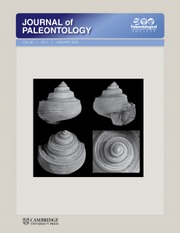Crossref Citations
This article has been cited by the following publications. This list is generated based on data provided by
Crossref.
Mitsopoulou, Vassiliki
Michailidis, Dimitrios
Theodorou, Evangelos
Isidorou, Stylianos
Roussiakis, Socrates
Vasilopoulos, Theodoros
Polydoras, Stamatios
Kaisarlis, Georgios
Spitas, Vasileios
Stathopoulou, Elizabeth
Provatidis, Christophoros
and
Theodorou, George
2015.
Digitizing, modelling and 3D printing of skeletal digital models of Palaeoloxodon tiliensis (Tilos, Dodecanese, Greece).
Quaternary International,
Vol. 379,
Issue. ,
p.
4.
Balanoff, Amy M.
Bever, G. S.
Colbert, Matthew W.
Clarke, Julia A.
Field, Daniel J.
Gignac, Paul M.
Ksepka, Daniel T.
Ridgely, Ryan C.
Smith, N. Adam
Torres, Christopher R.
Walsh, Stig
and
Witmer, Lawrence M.
2016.
Best practices for digitally constructing endocranial casts: examples from birds and their dinosaurian relatives.
Journal of Anatomy,
Vol. 229,
Issue. 2,
p.
173.
Lautenschlager, Stephan
2016.
Reconstructing the past: methods and techniques for the digital restoration of fossils.
Royal Society Open Science,
Vol. 3,
Issue. 10,
p.
160342.
Fau, Marine
Cornette, Raphaël
and
Houssaye, Alexandra
2016.
Photogrammetry for 3D digitizing bones of mounted skeletons: Potential and limits.
Comptes Rendus Palevol,
Vol. 15,
Issue. 8,
p.
968.
Balanoff, A.M.
and
Bever, G.S.
2017.
Evolution of Nervous Systems.
p.
223.
Moya-Costa, Raquel
Cuenca-Bescós, Gloria
Bauluz, Blanca
and
Lozano, Sergi
2019.
Protocol for the reconstruction of micromammals from fossils. Two case studies: The skulls of Beremendia fissidens and Dolinasorex glyphodon.
PLOS ONE,
Vol. 14,
Issue. 3,
p.
e0213174.
Tamborini, Marco
2020.
Technoscientific approaches to deep time.
Studies in History and Philosophy of Science Part A,
Vol. 79,
Issue. ,
p.
57.
Smith, Holly Ellen
Morley, Mike W.
and
Louys, Julien
2020.
Taphonomic Analyses of Cave Breccia in Southeast Asia: A Review and Future Directions.
Open Quaternary,
Vol. 6,
Issue. ,
p.
13.
Balanoff, A.M.
and
Bever, G.S.
2020.
Evolutionary Neuroscience.
p.
29.
Bauer, Jennifer E.
and
Rahman, Imran A.
2021.
Virtual Paleontology.
Leshno Afriat, Yael
Edelman‐Furstenberg, Yael
Rabinovich, Rivka
Todd, Jonathan A.
May, Hila
and
Hautmann, Michael
2021.
Taxonomic identification using virtual palaeontology and geometric morphometrics: a case study of Jurassic nerineoidean gastropods.
Palaeontology,
Vol. 64,
Issue. 2,
p.
249.
Tamborini, Marco
2022.
A Plea for a New Synthesis: From Twentieth-Century Paleobiology to Twenty-First-Century Paleontology and Back Again.
Biology,
Vol. 11,
Issue. 8,
p.
1120.
PORRO, Laura B.
MARTIN-SILVERSTONE, Elizabeth
and
RAYFIELD, Emily J.
2024.
Descriptive anatomy and three-dimensional reconstruction of the skull of the tetrapod Eoherpeton watsoni Panchen, 1975 from the Carboniferous of Scotland.
Earth and Environmental Science Transactions of the Royal Society of Edinburgh,
Vol. 115,
Issue. 3-4,
p.
164.
Nagel-Myers, Judith
Walrath, Krista A
and
Bowdish, Maeve C
2024.
Using two- and three-dimensional landmark data to examine the shape variation of Elliptio complanata from two heavily impounded rivers in northern New York (USA).
Journal of Molluscan Studies,
Vol. 90,
Issue. 4,
Howard, Cecilia M.
Sheldon, Nathan D.
Smith, Selena Y.
and
Noffke, Nora
2024.
Interpreting an Archaean paleoenvironment through 3D imagery of microbialites.
Geobiology,
Vol. 22,
Issue. 3,

